Background
Originally intended to be the third movie in Hammer's Dracula series (which began with 1958's Dracula with Christopher Lee and Peter Cushing, and was followed by 1960's The Brides of Dracula with Cushing alone), it was another attempt by Hammer to make a Dracula sequel without Christopher Lee. The final script by Anthony Hinds makes no reference to Dracula and expands on the directions taken in Brides by portraying vampirism as a social disease afflicting those who choose a decadent lifestyle.
The job of directing was offered to Don Sharp, who later said he had never seen a horror film before being asked to the job by Tony Hinds. Hinds told Sharp he thought the director would be ideal based on Sharp's other work. The director watched Curse of Frankenstein, Dracula and Stranglers from Bombay and became enthusiastic. [2]
"What intrigued me about them was after about 20 minutes I was totally hooked despite a totally absurd situation," he said later. "I thought it was wonderful - here was a genre with its own ground rules and self contained world and you could be theatrical but treat it realistically to grab the audience and make them believe something absurd." [2]
Sharp said he was worried that "as Hammer progressed, the goal seemed to be for each picture to top the one before it and they were becoming satiated with violence. So I persuaded Tony that it was better to suggest 'Is it going to happen?' and give the audience a little touch of it, and then go on and really get your big shock at the end. There could be a good size shock in the middle too but not all the time." [3]
Sharp said "I've always believed there needs to be a separation between suspense and shock. You lead on a mood but if you introduce the shock moment too quickly then it's expected. If you hang on keeping the same mood and tempo as the rest of the sequence, and then shatter the mood with a sudden violent moment, that's when it really works." [3]
The film went into production on 7 September 1962 at Bray Studios. It was not released until 1964. [4]
Sharp enjoyed making the film and later said Tony Hinds was the best producer he ever worked with. [5]
This is the only credited feature film screen role of Jacquie Wallis, who plays Sabena.
The film's climax, involving black magic and swarms of bats, was intended to be the ending of The Brides of Dracula, but the star of that film, Peter Cushing, objected that Van Helsing would never resort to black sorcery. However, the paperback novelization of Brides does use this ending.
Alternate version
Retitled Kiss of Evil for American TV, Universal trimmed so much of the original film for its initial television screening that more footage had to be shot to fill the missing time. Additional characters that didn't appear at all in the original release were added, creating a whole new subplot. Every scene that showed blood was edited out, e.g. the pre-credits scene in which blood gushes from the coffin of Zimmer's daughter after he plunges a shovel into it. Also, in the televised version it is never revealed what Marianne sees behind the curtain (Ravna lying on his bed with blood trickling from the corners of his mouth), a sight which makes her scream. A couple of the cuts result in scenes that no longer make sense: while the theatrical release had Harcourt smearing the blood on his chest into a cross-shaped pattern (keeping the vampires away as he escapes), the televised version omits the blood-smearing, leaving the vampires' inaction unexplained.
The additional footage shot for the televised version revolves around a family, the Stanghers, who argue about the influence of the vampiric Ravna clan but never interact with anybody else in the movie. The teenage daughter, Theresa, throws over her boyfriend in favor of Carl Ravna (unseen in these scenes) who has given her a music box which plays the same hypnotic tune that he plays on the piano elsewhere in the movie.
Critical reception
Howard Thompson of The New York Times wrote,"Until the picture floridly hops off the track toward the end, this horror exercise is a quietly stylish, ice-cold treat, beautifully tinted, well-directed (Don Sharp) and persuasively acted (Edward de Souza and Jennifer Daniel have the leads)." [6] Variety wrote "Horror fans will dig this latest effort from the Hammer Film shop in Britain. It is a slickly-produced color story of evil doings in Bavaria, circa 1910, replete with suspense, demonism and mystery tightly wrapped in a skillful package of effective performance and well-paced direction." [7] The Monthly Film Bulletin wrote "No new developments seem to have emerged in the vampire world, and this film is a straightforward and rather tame rehash of the standard formula...The direction is competent enough, though Don Sharp reveals no flair for this kind of thing, and there is a signal lack of atmosphere." [8]
The review aggregator Rotten Tomatoes reported an approval rating of 88%, with an average score of 7.2/10, based on 8 reviews. [9]
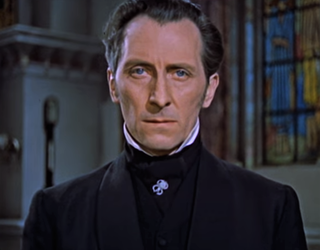
Peter Wilton Cushing was an English actor. His acting career spanned over six decades and included appearances in more than 100 films, as well as many television, stage, and radio roles. He achieved recognition in his home country for his leading performances in the Hammer Productions horror films from the 1950s to 1970s, while earning international prominence as Grand Moff Tarkin in Star Wars (1977).
Hammer Film Productions Ltd. is a British film production company based in London. Founded in 1934, the company is best known for a series of Gothic horror and fantasy films made from the mid-1950s until the 1970s. Many of these involve classic horror characters such as Baron Victor Frankenstein, Count Dracula, and the Mummy, which Hammer reintroduced to audiences by filming them in vivid colour for the first time. Hammer also produced science fiction, thrillers, film noir and comedies, as well as, in later years, television series.

Dracula is a 1958 British gothic horror film directed by Terence Fisher and written by Jimmy Sangster based on Bram Stoker's 1897 novel of the same name. The first in the series of Hammer Horror films starring Christopher Lee as Count Dracula, the film also features Peter Cushing as Doctor Van Helsing, along with Michael Gough, Melissa Stribling, Carol Marsh, and John Van Eyssen. In the United States, the film was retitled Horror of Dracula to avoid confusion with the U.S. original by Universal Pictures, 1931's Dracula.

Terence Fisher was a British film director best known for his work for Hammer Films.

Dracula Has Risen from the Grave is a 1968 British supernatural horror film directed by Freddie Francis and produced by Hammer Film Productions. It is the fourth entry in Hammer's Dracula series, and the third to feature Christopher Lee as Count Dracula, the titular vampire. The film stars Rupert Davies as a clergyman who exorcises Dracula's castle, and in doing so, unwittingly resurrects the Count back from the dead.
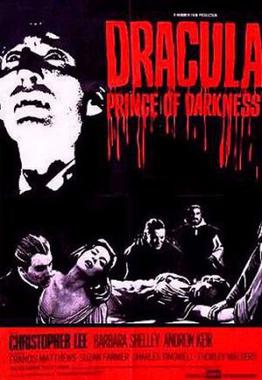
Dracula: Prince of Darkness is a 1966 British supernatural horror film directed by Terence Fisher. The film was produced by Hammer Film Productions, and is the third entry in Hammer's Dracula series, as well as the second to feature Christopher Lee as Count Dracula, the titular vampire. It also stars Andrew Keir, Francis Matthews, and Barbara Shelley.
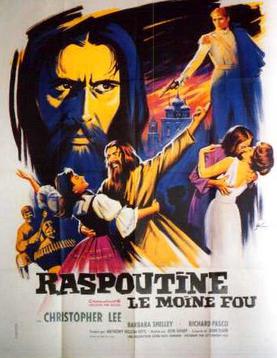
Rasputin the Mad Monk is a 1966 Hammer horror film directed by Don Sharp and starring Christopher Lee as Grigori Rasputin, the Russian peasant-mystic who gained great influence with the Tsars prior to the Russian Revolution. It also features Barbara Shelley, Francis Matthews, Suzan Farmer, Richard Pasco, Dinsdale Landen and Renée Asherson. The story is largely fictionalized, although some of the events leading up to Rasputin's assassination are very loosely based on Prince Yusupov's account of the story. For legal reasons, the character of Yusupov was replaced by Ivan (Matthews).
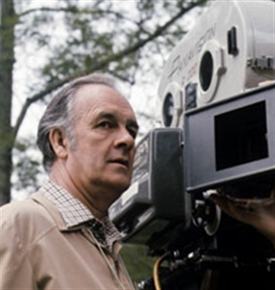
Donald Herman Sharp was an Australian film director.

The Brides of Dracula is a 1960 British supernatural horror film produced by Hammer Film Productions. Directed by Terence Fisher, the film stars Peter Cushing, David Peel, Freda Jackson, Yvonne Monlaur, Andrée Melly, and Martita Hunt. The film is a sequel to the 1958 film Dracula, though the character of Count Dracula does not appear in the film, and is instead mentioned only twice. Christopher Lee would reprise his role as Dracula in the next film in the Dracula series, Dracula: Prince of Darkness (1966).

The Legend of the 7 Golden Vampires is a 1974 martial arts horror film. The film opens in 1804, when seven vampires clad in gold masks are resurrected by Count Dracula, played by John Forbes-Robertson. A century later, Peter Cushing as Professor Van Helsing, known in the world for his exploits with Dracula, is recruited by a man and his seven siblings after giving a lecture at a Chinese university to take on the vampires. The film is a British-Hong Kong co-production between Hammer Film Productions and Shaw Brothers Studio.

The Satanic Rites of Dracula is a 1973 British horror film directed by Alan Gibson and produced by Hammer Film Productions. It is the eighth film in Hammer's Dracula series, and the seventh and final one to feature Christopher Lee as Dracula. The film was also the third to unite Peter Cushing as Van Helsing with Lee, following Dracula (1958) and Dracula A.D. 1972 (1972).

Lesbian vampirism is a trope in 20th-century exploitation film and literature. It was a way to hint at or titillate with the taboo idea of lesbianism in a fantasy context outside the heavily censored realm of social realism.

Taste the Blood of Dracula is a 1970 British supernatural horror film produced by Hammer Film Productions. Directed by Peter Sasdy from a script by Anthony Hinds, it is the fifth installment in Hammer's Dracula series, and the fourth to star Christopher Lee as Count Dracula, the titular vampire. The film also features Geoffrey Keen and Gwen Watford.

The Devil-Ship Pirates is a 1964 British pirate adventure film directed by Don Sharp.
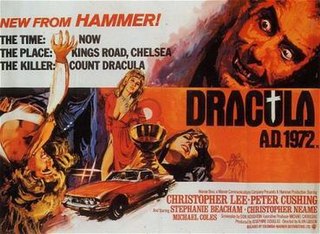
Dracula A.D. 1972 is a 1972 British horror film, directed by Alan Gibson and produced by Hammer Film Productions. It was written by Don Houghton and stars Christopher Lee, Peter Cushing and Stephanie Beacham. Unlike earlier films in Hammer's Dracula series, Dracula A.D. 1972 had a contemporary setting in an attempt to update the Dracula story for modern audiences. Dracula is brought back to life in modern London and preys on a group of young partygoers that includes the descendant of his nemesis, Van Helsing.

Lust for a Vampire, also known as Love for a Vampire or To Love a Vampire, is a 1971 British Hammer Horror film directed by Jimmy Sangster, starring Ralph Bates, Barbara Jefford, Suzanna Leigh, Michael Johnson, and Yutte Stensgaard. It was given an R rating in the United States for some violence, gore, strong adult content and nudity. It is the second film in the Karnstein Trilogy, loosely based on the 1872 Sheridan Le Fanu novella Carmilla. It was preceded by The Vampire Lovers (1970) and followed by Twins of Evil (1971). The three films do not form a chronological development, but use the Karnstein family as the source of the vampiric threat and were somewhat daring for the time in explicitly depicting lesbian themes.
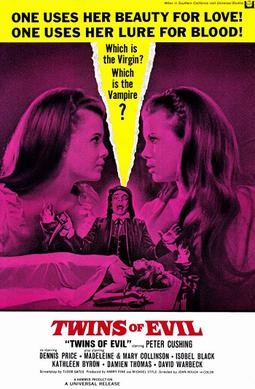
Twins of Evil is a 1971 British horror film directed by John Hough and starring Peter Cushing, with Damien Thomas and the real-life identical twins and former Playboy Playmates Mary and Madeleine Collinson.
Sir James Enrique Carreras was a British film producer and executive who, together with William Hinds, founded the British company Hammer Film Productions. His career spanned nearly 45 years, in multiple facets of the entertainment industry until retiring in 1972.
Dracula is the title of several horror film series centered on Count Dracula, who is accidentally resurrected, bringing with him a plague of vampirism, and the ensuing efforts of the heroic Van Helsing family to stop him.
The World of Hammer is a British television documentary series created and written by Robert Sidaway and Ashley Sidaway, and produced by Robert Sidaway.
















